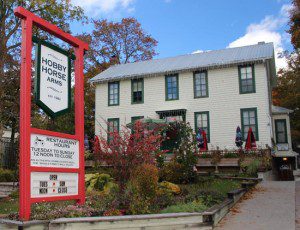
A Friday or two ago, after my wife and I had each endured a long, tough week, the two of us decided we needed a break. We chose not to eat in, but to treat ourselves. We dropped by the Hobby Horse, a local pub in Uxbridge, to enjoy a favourite beverage and meal and some relaxing down time. Of course, part of the experience of treating ourselves included enjoying one of the best servers in town – B.J. Byers.
“Hey, how are two of my favourite regulars?” B.J. said as we walked in.
“Great… now,” I responded.
Then, for the next hour or so, my wife and I enjoyed some of the Hobby’s specials, its beers on tap, and just enough conversation with B.J. to make the evening a delicious escape. Then, when it came time to leave and square up our account, I walked over to the bar, took the portable credit card device and keyed in the appropriate steps required to pay our bill and add a tip.
Out of habit, I do a mental percentage calculation, key in the gratuity and wait for the little device to tell me my debit has been “approved.” My wife and I do the same when we visit The Tin Mill, Scrambles or any of the other excellent eateries in town.
I was rather perplexed this week, however, when I read that some eating establishments in the Greater Toronto Area are considering a new approach to paying restaurant bills and tips. In corporate magazines they’re calling it “a new business model” to redistribute restaurant revenue among all those employed at an eating establishment.

The model, I learned, was introduced by Danny Meyer, the CEO at The Modern, one of New York City’s upscale dining destinations. Under the new scheme, gratuities would be eliminated, so that the restaurant could instead redistribute its income among its 1,800 workers in order to more fairly compensate the “back of the house” or kitchen staff.
“Many of our colleagues – our cooks, reservationists and dishwashers to name a few – aren’t able to share in our guests’ generosity,” Meyer told a CBC reporter, “even though their contributions are just as vital to (the) experience.”
But The Modern isn’t the leader in this trend. Actually, among the first to experiment with the no-tipping policy was a Canadian eatery, Smoke ’N Water, on Vancouver Island. The 190-seat restaurant introduced the no-tipping feature in 2014 – taking 15 per cent of its gross income (in lieu of tips) to pay additional wages to everybody from kitchen staff to servers. Within three months, there was so much backlash from customers and media that Smoke ’N Water owner David Jones cancelled the initiative, wishing in hindsight that he’d simply offered more balanced wages to all of his staff.

My own experience with calculating and distributing gratuities goes back to the 1960s, when my aunt and uncle in the U.S. invited me to their renowned eatery on the Beltway near Baltimore, Maryland. They responded to my request to earn some tuition money for my future university education by suggesting I work as a busboy at their Double-T Diner during that summer of 1966. I had no idea what I was getting myself into. The work came with long hours during the diner’s busiest time of the year, very little time off, and an offer that I would work for a base salary and what my uncle described as an additional bonus.
“Oh, at the end of your summer on the job,” he said, “the waitresses at the diner will gather up all their tips and share a percentage with you.”
I guess I should have asked for it in writing. Or, at least I should have consulted the waitresses themselves to verify the existence of this alleged gratuity pool and sharing arrangement. When the summer job at the diner came to an end around Labour Day, I asked one of the waitresses about the gratuity-sharing scheme. She looked at me as if I’d grown horns and claimed she’d never heard of such a thing. Besides, she told me, any tips were miniscule and long since spent anyway. I chalked up the evaporated gratuities to experience and came home to Toronto, just as glad to be out of that hot kitchen with a few dollars for tuition in my hand.
The idea of relying on the restaurateur (or a business model) to ensure equal pay for work of equal value paid to all restaurant employees I think is a pipe dream. And I also think most restaurant-goers would agree that good tips result from good service. On the other hand, I think it’s also fair for the industry to give its customers guidelines – 15 to 20 per cent as a base gratuity and more when extraordinary service warrants for it. That’s the business model I sense works best.